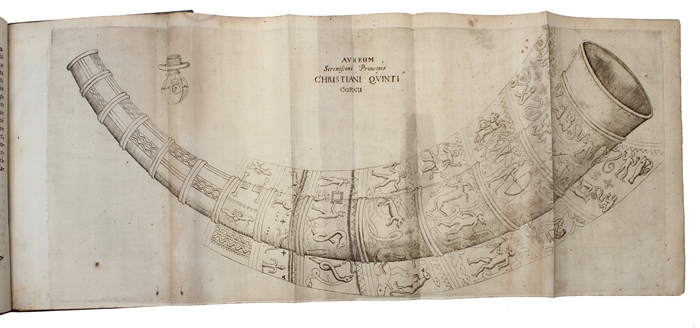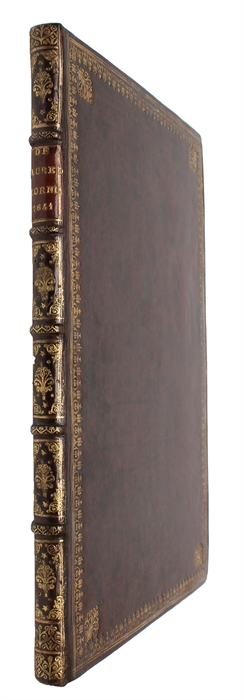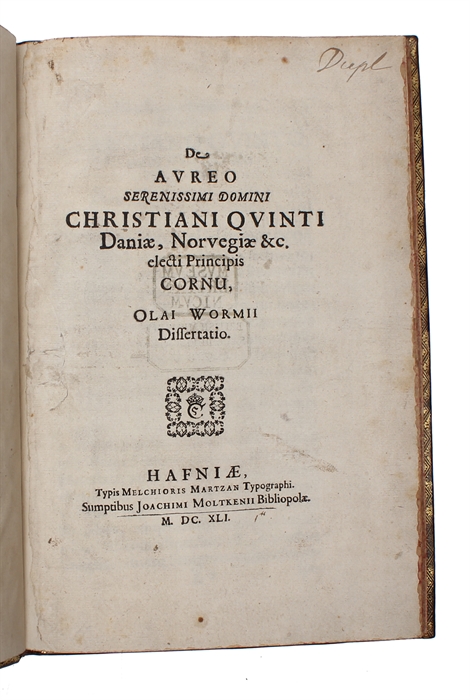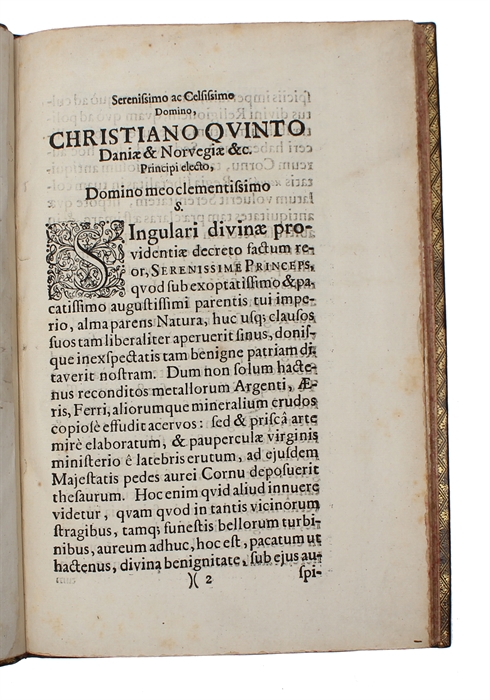THE FIRST AND MOST IMPORTANT TREATISE ON THE GOLDEN HORN
WORM, OLE.
De aureo Cornu. Dissertatio.
Hafniae (Copenhagen), Melchior Matzan, Joachim Moltke, 1641.
Small folio. Bound in an newer absolutely exquisite full mottled calf pastiche-binding with five raised bands and gilt title-label to richly gilt spine. Gilt ornamental borders with gilt corner-pieces to boards, all edges of boards gilt, and inner gilt dentelles. Title-page restored at inner hinge, far from affecting print. Some leaves slighly dusty and some mostly light brownspotting. Overall very nice indeed. The folded plate neatly re-enforced at the foldings, from verso, and on stub. "Dupl" written in hand to upper right corner of title-page and with two stamps to verso: "Museum Britannicum" and "British Museum Sale Duplicate 1787".
(8), 72 pp. + large folded engraved plate of the horn.
Exceedingly scarce first printing of one of the most important works in Scandinavian history. Worm’s monumental 1641-treatise is the first and single most important work on what is arguably the most famous Danish cultural artifact, namely the first Golden Horn, and constitutes our primary source of knowledge of that now lost treasure. For Danes, the Golden Horns, discovered on 1639 and 1734 respectively, with their amazing, complicated, and tragic story, constitute the Scandinavian equivalent to the Egyptian pyramids and have been the object of the same kind of fascination here in the North, causing a wealth of fantastical interpretations, both historical, literary, mystical, linguistic, and artistic. After the horn had been authenticated, it was sent to King Christian VI, where it was placed in a glass case in the royal art chamber, together with the first horn. Before being placed here, a copy was made of both horns. These copies were the ones lost in the ship wreck, however, and as mentioned the casts had already been destroyed. This monument of Danish cultural history is incredibly scarce in the trade. We have never seen a copy before, and there is not a single auction record traceable.
The two golden horns constitute the greatest National treasure that we have. They are both from abound 400 AD and are thought to have been a pair. A span of almost 100 years elapsed between the finding of the first horn and the finding of the second. Although the first was by far the most important, both findings are now a fundamental part of Danish cultural heritage.
In 1802 the horns were stolen, and the story of this theft became the greatest Danish detective story of all times. The thief was eventually caught, but it turned out that he had melted both of the horns and used the gold for other purposes.
Before the horns were stolen, a copy of the horns was made and shipped to the King of Italy, but the cast which was used to make this copy was destroyed, before news had reached the kingdom of Denmark that the copies made from the cast were lost on their way to Italy, in a shipwreck.
Worm's work constitutes not only the earliest description of the seminal first horn, but also the most important source that we now have to the knowledge of the horn. It is on the basis of the description and depiction in the present work that the later copies of the first horn were made.
Both horns were found in Gallehus near Møgeltønder, the first in 1639, by Kirsten Svendsdatter, the second in 1734, by Jerk (Erik) Lassen.
Kirsten Svendsdatter made her discovery on a small path near her house, initially thinking that she had stumbled upon a root. When she returned to the same place the following week, she dug up the alleged root with a stick, and mistook it for an old hunting horn. She brought it back home and began polishing it. During the polishing of it, a small piece broke off, which she brought to a goldsmith in Tønder. It turned out that the horn was made of pure gold, and rumors of Kirsten's find quickly spread. The horn was eventually brought to the King, Christian IV, and Kirsten was given a reward corresponding to the gold value of the horn. The king gave the horn to his son, who had a lid made for it so that he could use it as a drinking horn.
An excavation of the site where the horn was found was begun immediately after, but nothing more was found - that is until 95 years later when Jerk Larsen was digging clay on his grounds - merely 25 paces from where Kirsten had found the first horn. The year was now 1734. The horn that Larsen found was a bit smaller in size and was lacking the tip, but it still weighed 3,666 kg.
In the fatal year of 1802, the gold smith and counterfeiter Niels Heldenreich broke in to the royal art chamber and stole the horns. By the time the culprit was discovered, the horns were irrevocably lost - Heldenreich had melted them and used the gold to make other things, such as jewellery. A pair of earrings that are still preserved are thought to have been made with gold from the horns, but this is all that we have now have of the original horns.
New horns were produced on the basis of the descriptions and engraved illustrations that were made after the finding of the horns. The plate in the present work constitutes our main source of knowledge of the appearance of the first horn and is the single most important depiction of it, forming the basis of the reproductions.
"The longest of the golden horns was found in 1639 and described by Ole Worm in the book 'De Aureo Cornu', 1641 (a treatise which is also included in his greater "Danicorum Monumentorum" [1643]). The German professor at Soro Academy Hendrich Ernst, disagreed with Worm’s interpretation of the horn. Ernst believed that the horn came from Svantevits temple on Rügen, while Worm interpreted it as a war trumpet from the time of Frode Fredegods, decorated with pictures, calling for virtue and good morals. Worm immediately sent his book to Prince Christian and the scholars at home and abroad. You can see in his letters, that not only did the horn make an impression, but also the letter and the interpretation. In that same year there were such lively discussions on the horn among the scholars of Königsberg, now Kaliningrad!
In 1643 Worm reiterated the description of the golden horn in his great work on Danish runic inscriptions, 'Monumenta Danica'. In 1644, his descriptions of the horn reached scholars and libraries in Schleswig, Königsberg, London, Rome, Venice and Padua. Several learned men wrote poems for him, and the golden horn was mentioned in an Italian manus. Map Cartoonist Johannes Meyer placed the finds on several of his map of South Jutland.
When the Swedish commander Torstensson attacked Jutland in 1643, Peter Winstrup wrote a long poem in Latin addressed to the bishop of Scania (which at that time still belonged to Denmark), the poem was called 'Cornicen Danicus'. It was immediately translated into Danish, entitled 'The Danish Horn Blower'. He interpreted the horn and its images as a warning of war, and his interpretations were very hostile to the Swedish. Paul Egard and Enevold Nielssen Randulf were among some of the other scholars who interpreted the Golden Horn In the 1640s. They were both deans in Holstein, and had a more Christian interpretation of the horn.
All these works were illustrated with copies of Worms depictions of the horn. The Golden Horn remained known throughout the 1600s, both in terms of interpretations of the horn and designs. The found of the short golden horn in 1734 renewed the interest of the meaning of the horns." (National Museum of Denmark).
Order-nr.: 60808




